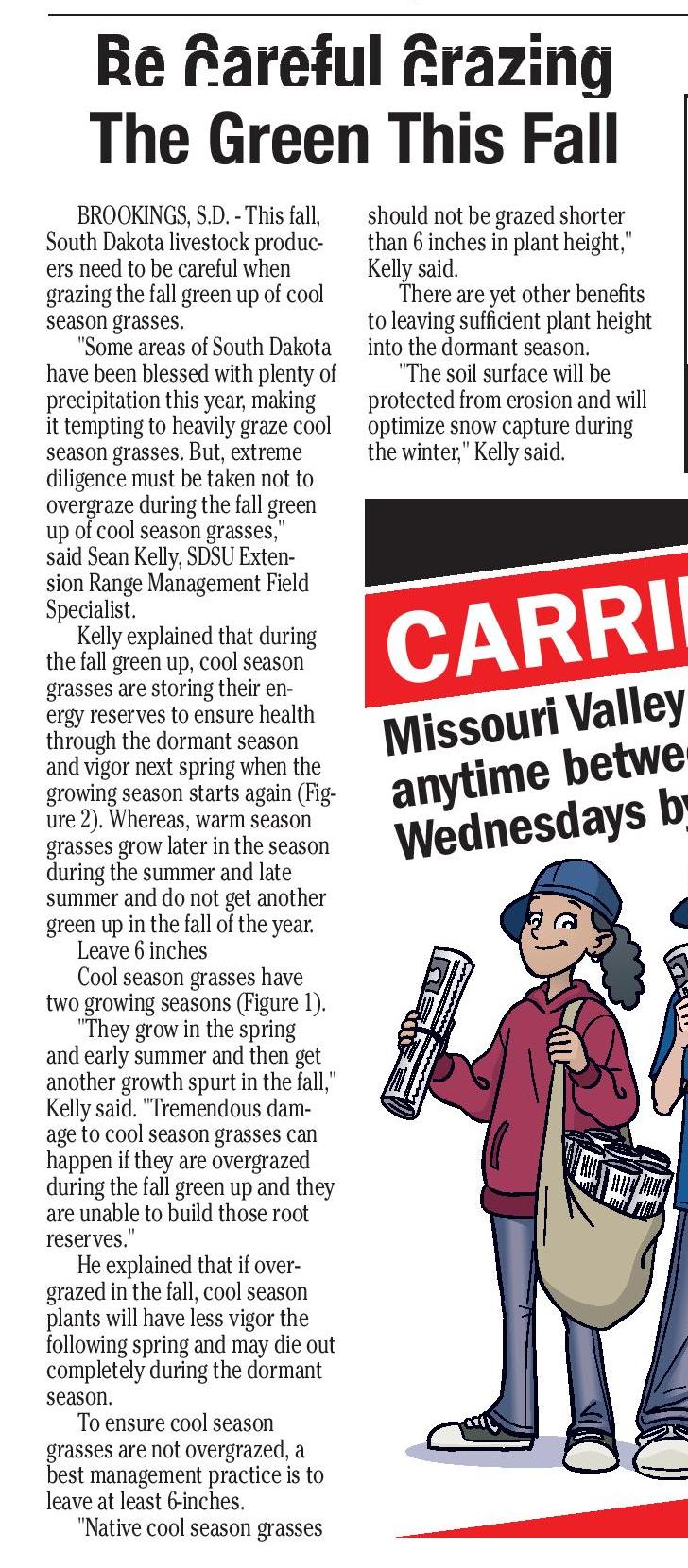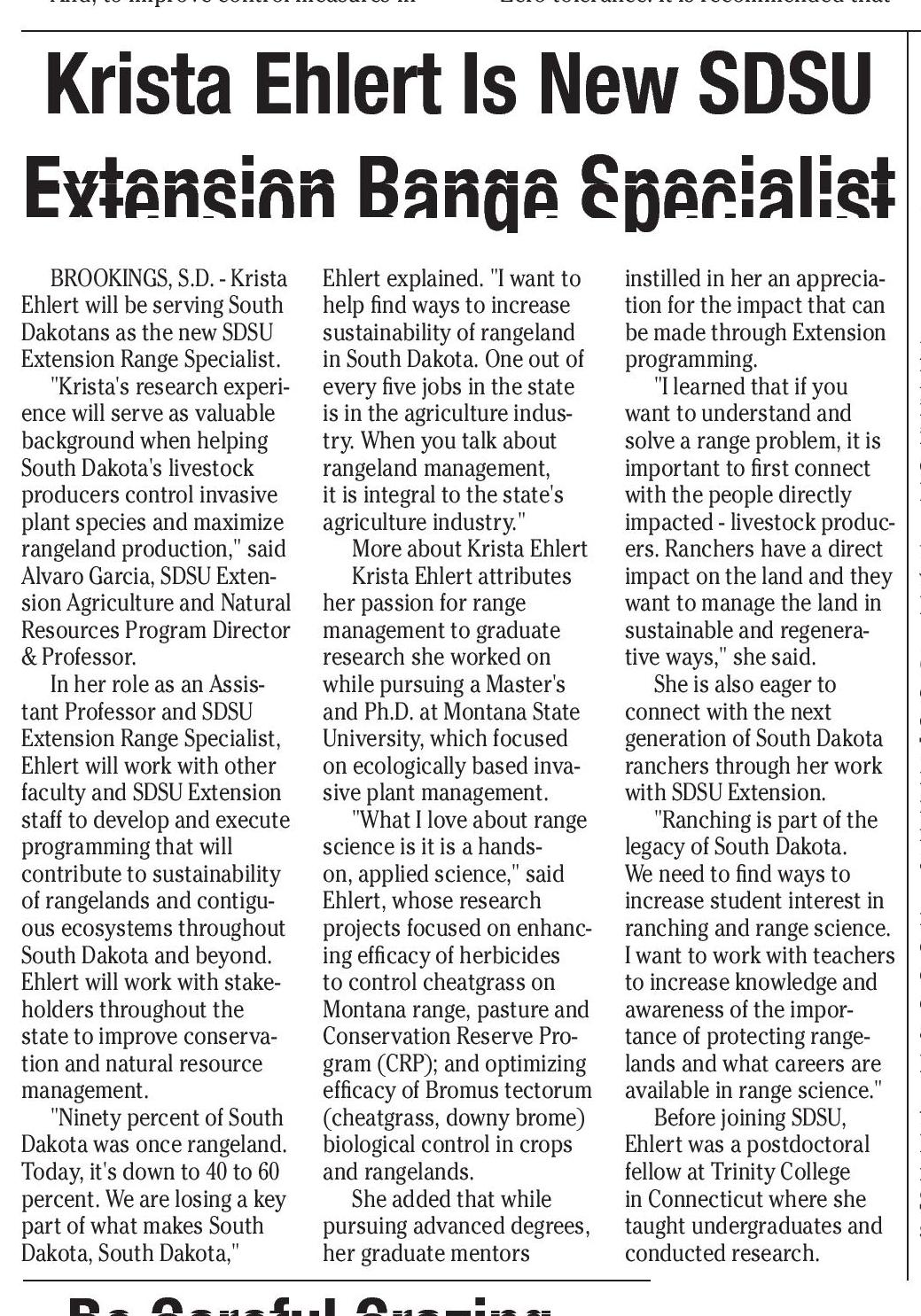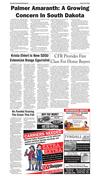103018_YKMV_A5.pdf








shop online at www.missourivalleyshopper.com
October 30, 2018 • Page 5
Palmer Amaranth: A Growing
Concern In South Dakota
BROOKINGS, S.D. - Although Palmer
Amaranth can be found in South Dakota,
it is currently not wide spread. SDSU
Extension staff say it may be possible
to limit the scope and economic burden
this weed could cause if South Dakota
producers and agronomists are vigilant
throughout harvest and into 2019 growing
season.
"If producers come across a patch of
Palmer Amaranth in their fields during
harvest, they should consider bypassing
those areas," said Ruth Beck, SDSU Extension Agronomy Field Specialist.
Beck explained that combining mature
Palmer Amaranth or other pigweeds is
not recommended. "However, if combine
harvest cannot be avoided, leaving those
areas till last will help keep from moving
these weeds to other fields or spreading
them further in the field where they are
found," Beck said.
Before leaving the infested area,
harvest equipment should be thoroughly
cleaned.
And, to improve control measures in
2019, Beck encourages producers to make
note of infested areas.
"Those areas will need to be treated
with a strong preplant/preemerge herbicide program and a follow-up post emerge
application next year," said Paul O.
Johnson, SDSU Extension Weed Science
Coordinator.
Using herbicides with long residuals
and multiple modes of action is recommended.
Field management practices to control
Palmer Amaranth
If Palmer Amaranth is found in a field
this fall, Beck outlined some best management practices to help control the weed.
No-till: Managing infested areas of the
field with no-till will keep seeds on the
surface where they are exposed to weather extremes and predation from birds and
insects. Whereas, shallow tillage favors
germination.
Crop rotation: Crop rotations that
include wheat, corn and milo will give
producers more control options.
Zero tolerance: It is recommended that
producers employ a zero tolerance approach to controlling this weed.
This may include hand removal of
escapees. "Keeping the field clean until
the crop canopies will help with control
of this weed," Beck said. "Emergence will
drop significantly after crop canopy."
Palmer Amaranth ID tips
Palmer Amaranth was introduced to
South Dakota through seed, equipment,
feed and manure.
It is a versatile weed whose male and
female parts exist on different plants, so,
it needs to cross pollinate to produce
seed, explained Johnson.
"The process of cross pollination
increases the plants genetic diversity and
its ability to develop plant types that are
resistant to herbicides," Johnson said.
A prolific seed producer, Palmer Amaranth has the ability to germinate for an
extended period during the summer, grow
quickly and compete aggressively with
crops for nutrients, light and moisture.
It is difficult to identify Palmer Amaranth from other pigweed species when
the plants are small.
However, Palmer does have some
unique features and these will become
more obvious as the plant ages, said
Gared Shaffer, SDSU Extension Weeds
Field Specialist.
Stem: The stem of Palmer is smooth,
where other pigweeds, such as redroot
pigweed has hairs.
Leaves: Although waterhemp also has
a smooth stem, its leaves usually have a
narrow lanceolate shape versus Palmer
Amaranth which has leaves that are more
diamond shaped or broader across.
Petiole: Another feature unique to
Palmer Amaranth is a long petiole.
Spiny bract: Palmer amaranth can
have a spiny bract where the petiole
attaches to the main stem. This spiny
bract is not common in redroot pigweed
or in waterhemp. "Once Palmer Amaranth
develops a seed head it becomes easier
to distinguish, as the terminal seed head
is usually very long," Shaffer said.
Krista Ehlert Is New SDSU
CFR Provides Free
Extension Range Specialist Class For Home Buyers
BROOKINGS, S.D. - Krista
Ehlert will be serving South
Dakotans as the new SDSU
Extension Range Specialist.
"Krista's research experience will serve as valuable
background when helping
South Dakota's livestock
producers control invasive
plant species and maximize
rangeland production," said
Alvaro Garcia, SDSU Extension Agriculture and Natural
Resources Program Director
& Professor.
In her role as an Assistant Professor and SDSU
Extension Range Specialist,
Ehlert will work with other
faculty and SDSU Extension
staff to develop and execute
programming that will
contribute to sustainability
of rangelands and contiguous ecosystems throughout
South Dakota and beyond.
Ehlert will work with stakeholders throughout the
state to improve conservation and natural resource
management.
"Ninety percent of South
Dakota was once rangeland.
Today, it's down to 40 to 60
percent. We are losing a key
part of what makes South
Dakota, South Dakota,"
Ehlert explained. "I want to
help find ways to increase
sustainability of rangeland
in South Dakota. One out of
every five jobs in the state
is in the agriculture industry. When you talk about
rangeland management,
it is integral to the state's
agriculture industry."
More about Krista Ehlert
Krista Ehlert attributes
her passion for range
management to graduate
research she worked on
while pursuing a Master's
and Ph.D. at Montana State
University, which focused
on ecologically based invasive plant management.
"What I love about range
science is it is a handson, applied science," said
Ehlert, whose research
projects focused on enhancing efficacy of herbicides
to control cheatgrass on
Montana range, pasture and
Conservation Reserve Program (CRP); and optimizing
efficacy of Bromus tectorum
(cheatgrass, downy brome)
biological control in crops
and rangelands.
She added that while
pursuing advanced degrees,
her graduate mentors
Be Careful Grazing
The Green This Fall
BROOKINGS, S.D. - This fall,
South Dakota livestock producers need to be careful when
grazing the fall green up of cool
season grasses.
"Some areas of South Dakota
have been blessed with plenty of
precipitation this year, making
it tempting to heavily graze cool
season grasses. But, extreme
diligence must be taken not to
overgraze during the fall green
up of cool season grasses,"
said Sean Kelly, SDSU Extension Range Management Field
Specialist.
Kelly explained that during
the fall green up, cool season
grasses are storing their energy reserves to ensure health
through the dormant season
and vigor next spring when the
growing season starts again (Figure 2). Whereas, warm season
grasses grow later in the season
during the summer and late
summer and do not get another
green up in the fall of the year.
Leave 6 inches
Cool season grasses have
two growing seasons (Figure 1).
"They grow in the spring
and early summer and then get
another growth spurt in the fall,"
Kelly said. "Tremendous damage to cool season grasses can
happen if they are overgrazed
during the fall green up and they
are unable to build those root
reserves."
He explained that if overgrazed in the fall, cool season
plants will have less vigor the
following spring and may die out
completely during the dormant
season.
To ensure cool season
grasses are not overgrazed, a
best management practice is to
leave at least 6-inches.
"Native cool season grasses
should not be grazed shorter
than 6 inches in plant height,"
Kelly said.
There are yet other benefits
to leaving sufficient plant height
into the dormant season.
"The soil surface will be
protected from erosion and will
optimize snow capture during
the winter," Kelly said.
instilled in her an appreciation for the impact that can
be made through Extension
programming.
"I learned that if you
want to understand and
solve a range problem, it is
important to first connect
with the people directly
impacted - livestock producers. Ranchers have a direct
impact on the land and they
want to manage the land in
sustainable and regenerative ways," she said.
She is also eager to
connect with the next
generation of South Dakota
ranchers through her work
with SDSU Extension.
"Ranching is part of the
legacy of South Dakota.
We need to find ways to
increase student interest in
ranching and range science.
I want to work with teachers
to increase knowledge and
awareness of the importance of protecting rangelands and what careers are
available in range science."
Before joining SDSU,
Ehlert was a postdoctoral
fellow at Trinity College
in Connecticut where she
taught undergraduates and
conducted research.
November’s free Saturday class will be
November 3rd, 10:00 AM – 4:30 PM at the
Downtown Library at 200 N Dakota Ave..
in Sioux Falls. Lunch will be provided for
in-person participants. Those interested
can register through the calendar at www.
LssSD.org or by calling 888-258-2227.
Video conference is available for those
unable to attend in person. To attend by
video conference, you must register at
least 24 hours in advance.
The Center for Financial Resources’
(CFR) free Homebuyer Express class is
open to anyone considering a home purchase or already in the purchase process.
Topics include: personal money management; credit history review; mortgage
financing and the loan process; shopping
for a home; homeowner responsibilities;
and predatory lending awareness.
Those who have attended in the past
report a higher level of confidence and
comfort in moving forward with the purchase process and a reduction in anxiety
over the purchase process. Attendees
are welcome at any point in the purchase
process.
Homebuyer Express is free and open
to the public. The LSS Center for Financial
Resources’ Homebuyer Express series is
made possible through a grant from the
SDHDA Homeownership Education Resource Organization (H.E.R.O.). H.E.R.O.
Why pay more?
2015 Ford Explorer
XLT 4x4
Certificates of Completion are issued to
participants after attending both parts 1
and 2. Required for some loan types and
down payment assistance programs, the
certificate may also qualify individuals for
closing cost credits. The H.E.R.O certificate does not expire, so attendees can
attend early in the buying process.
Lutheran Social Services is a private
non-profit social service agency. Last
year, 61,144 lives were touched through
a variety of services offered through LSS
statewide.
Core services offered by LSS include
adoption, pregnancy counseling, foster
care, kinship services, childcare & education, disaster response, mental health
counseling, re-entry services, Center for
Financial Resources, residential services
for children & youth, alternatives to
detention, independent living services
for young adults, mentoring, Better Together and Center for New Americans.
LSS serves people of all ages, races, faiths
and economic levels with professional,
confidential and affordable services.
LSS services are licensed by the State
of South Dakota and accredited by the
Council on Accreditation. LSS is a United
Way agency.
Earn as much as $400+ this month
& $120 this week
Metallic Black, Black Leather, 3.5L
V6 Full Power, 33K, 3 Row Seating
$19,500
Salvage Title
605-665-3720 • Yankton, SD
EEDvEeD
RIEhRpersNn be deli nd d TYNDALL
R y S opS ca gs aer
CA ri Valle
mornin
u
day
Misso
ween Tuesm.
t
anytime beys by 6:00p
Wednesda
Dealer For Livestock Equipment
XTRA
E
XTRA
E
g money?
e spendin
Need som
or tunity!
erfect opp
p
le
This is the
w availab
routes no
Yankton
We have calving pen,
single and double bale
feeders on hand!
Now A Ritchie
Fountain Dealer
Livestock watering products.
We stock a line of parts
and accessories
Wooden Post, Blunt & Pointed
Just in Time for Fall Fence Repair
ut
319 Waln
nkton, SD
Street, Ya
802 Main St.
884
Tyndall, SD
605-665-5
ve at
605-589-4700
Call Ste
Mon. to Fri. 8am - 6pm
Saturday 8am - 5pm
Sunday 10am - 2pm





















 Previous Page
Previous Page





